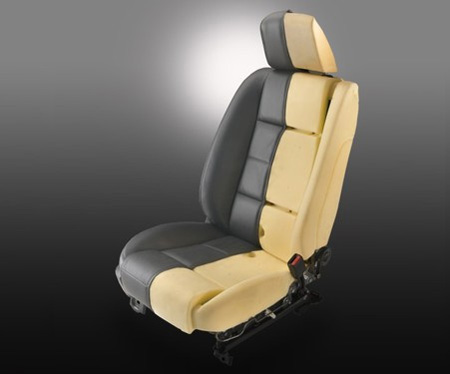Ford investiert in Soja

Der neue Ford Mustang 2008, vollgestopft mit Bohnen? Wie Ford jetzt bekannt gab, werden die neuen Sitze des 2008 Ford Mustang Modelles, aus umweltfreundlichen Sojabohnen produziert! In zusammenarbeit mit der Lear Corporation werden diese neuen Sitze produziert und im August erstmals verbaut. Dabei werden die neuen Sitze nahezu dreiviertel aus erneuerbaren Material sein, ausserdem wird der CO² Ausstoss bei der Herstellung verringert. Ford experimentiert bereits seit ihrem Ford Model T mit Sojabohnen, dieser hatte bereits 60 Pfund Bohnen, in seinem Lack und einigen Plastikteilen, verbaut.
FORD, LEAR TO LAUNCH INDUSTRY’S FIRST SOY BASED SEAT FOAM IN 2008 FORD MUSTANG
DEARBORN, Mich., July 12 – Ford Motor Company [NYSE:F] and Lear Corporation [NYSE: LEA] will mark an automotive milestone in August when production of soy-based foam for seats begins in the 2008 model year Ford Mustang.
America’s beloved pony car will use the industry’s first soy-based flexible foam in the seat backs and seat cushions beginning in August at the Auto Alliance International factory in Flat Rock, Michigan, home of the Ford Mustang.
Ford has a rich history in incorporating soy based materials into its products. The Model T, for example, once contained 60 pounds of soybeans in its paint and molded plastic parts. Ford again showcased its industry-leading work with soy-foams in 2003 on the Model U concept, which featured soy-based seat cushions as well as a soy-based resin composite tailgate.
„Our technical team had to overcome several significant hurdles to bring this environmentally responsible technology to production,“ said Gerhard Schmidt, vice president of Research & Advanced Engineering at Ford Motor Company. „We are pleased that our diligent efforts in developing this technology have resulted in the production of soy-foam for the Ford Mustang.“
Ford was the first automaker in the world to demonstrate that soy-based polyols could be used at high percentage levels to make foam capable of meeting or exceeding automotive requirements. In 2004, Ford and Lear formed a partnership to commercialize soy-foam applications, with initial work concentrating on the molding of headrest and armrest components.
Lear is a leader in the area of environmental systems for automotive seating with industry firsts, such as the use of expanded polypropylene and polyethylene materials. These materials are used in place of traditional polyurethane foam which offers lower mass and is 100 percent recyclable.
„Using renewable resources is an important means to supplying automotive products that improve environmental impact,“ said Ray Scott, senior vice president and president of Lear’s Seating Systems Division. „This also helps in reducing the amount of pollution in the production of materials for automotive use. Ford Motor Company and Lear Corporation are able to bring this product to market ahead of our competitors due largely to our collaborative work with in the area of ‚Green‘ technology.“
The environmental advantages of soy-foam include: a reduction of carbon dioxide (CO2) emissions when compared to current petroleum-based material, lower energy required to produce the material, up to 24 percent renewable content, and a reduction of dependence on volatile energy markets.
Ford and Lear collaborated with the United Soybean Board – New Uses Committee (a group of 64 farmers and agriculture industry leaders), Urethane Soy Systems Company, Bayer Corporation and Renosol Corporation on soy-foam development.
Friendlier to the Environment
„Soy is a very green, renewable resource,“ says Debbie Mielewski, technical leader for Ford’s Materials Research & Advanced Engineering Department. „Using soy-based foam gives us the opportunity to conserve natural resources and reduce our environmental footprint.“
Most automotive manufacturers today use 100 percent petroleum-based polyol foam. Each vehicle produced today contains an average of 30 pounds of petroleum-based foam. The total annual worldwide market for the foam is 9 billion pounds. Milewski says auto manufacturers research and development of renewable, more environmentally friendly materials to produce the foam, could have a significant environmental impact.
[Source: AutoblogGreen]
Leave a comment
